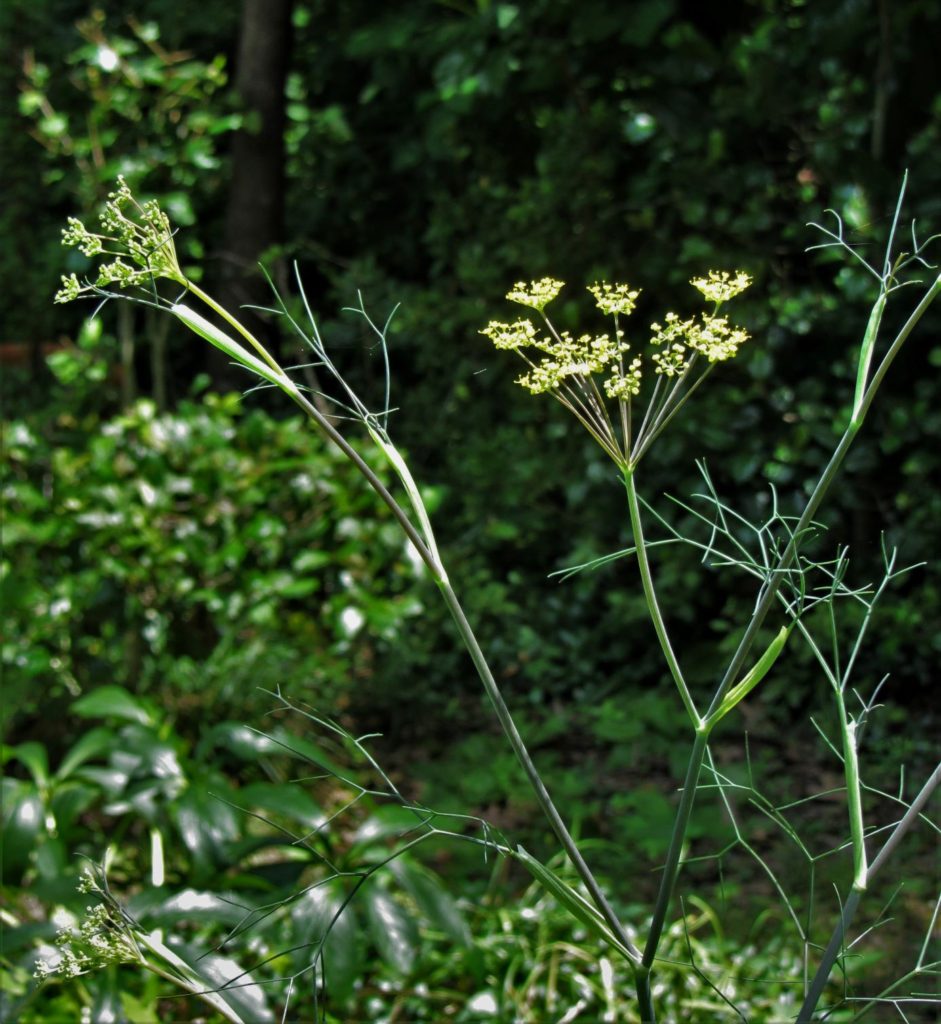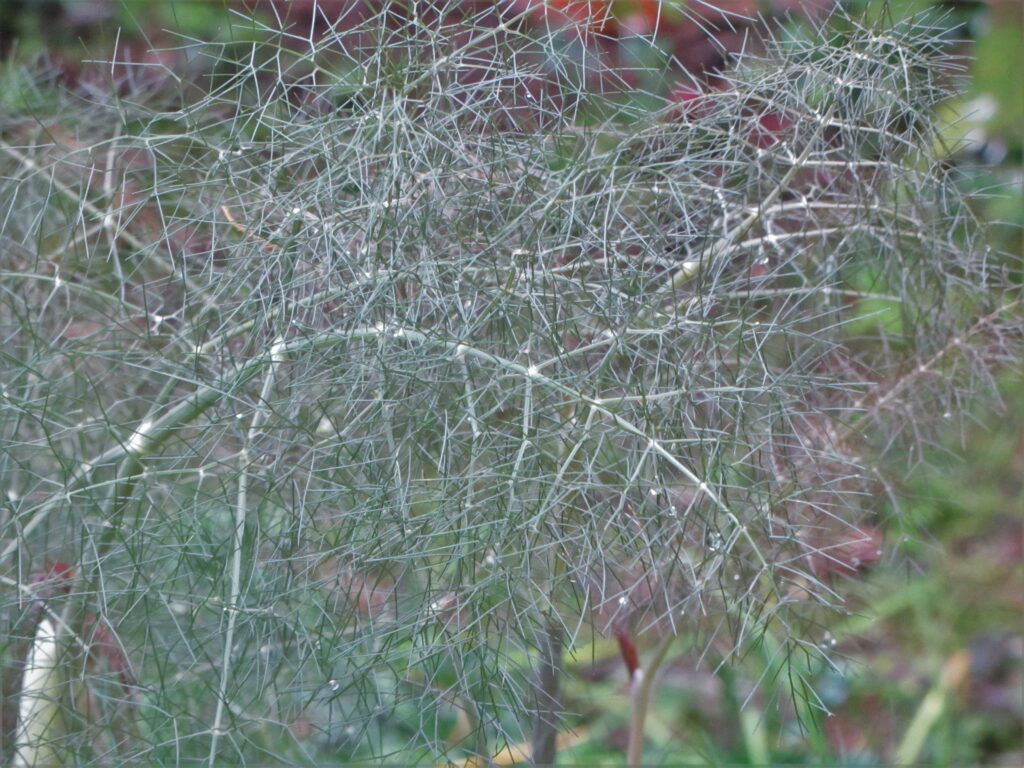Protect Your Garden with Alliums, Gingers, and Herbs
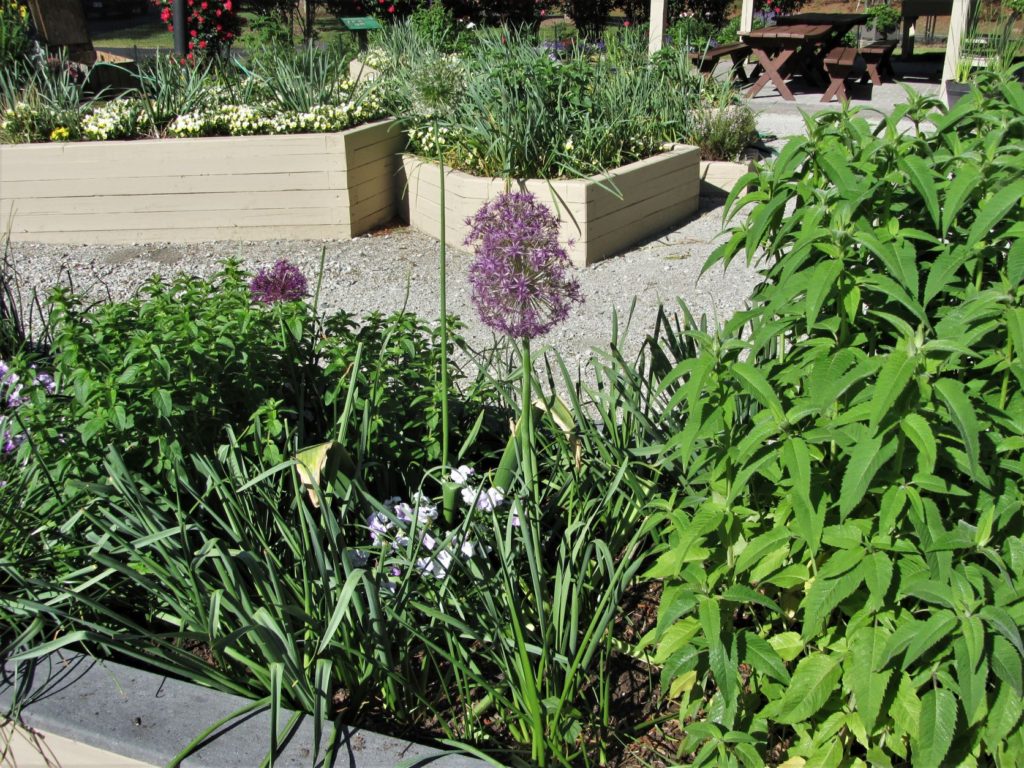
Alliums and fragrant herbs will often protect nearby tasty plants from grazers. This bed is was planted by participants in the ARC Therapeutic Gardening Project at the Williamsburg Botanical Garden, where hungry bunnies sometimes climb into raised beds to feed.
Have You Eaten?
Animals engage in the business of eating; there is no common ground between our desire for a beautiful and productive garden and a deer or rabbit’s need for lunch. While we may garden in harmony with birds harvesting berries from our shrubs and bees harvesting nectar and pollen from our flowers, it is mainly because they can assist us with our gardening tasks and feed themselves without destroying our plants.
Birds and spiders eat mostly insects, helping us with pest control. Bees, beetles, flies, ants, and wasps pollinate our flowers throughout the year, keeping plants productive and ensuring enough seeds to plant the next generation. Butterflies entertain us with their beauty while they sip nectar and help with pollination. Even the occasional turtle, lizard, bat, or frog visiting our garden does us a favor by eating bugs, snails, and slugs.
And the Always Hungry Deer…
But deer? We find ourselves in competition with them for our most prized garden plants. Have you ever nurtured a tomato plant, laden with ripening fruit, only to find it grazed to the stem? Have deer ever treated your roses or Hydrangeas like a buffet salad bar? Most of our favorite garden flowers, fruits, and vegetables attract the always hungry deer. The more we plant, the more popular our yards become.
While the only 100% effective solution to protect our garden from deer is an impenetrable high fence, many us living in neighborhoods don’t have that option because our HOAs or neighborhood covenants won’t allow such fences. So, we turn to a variety of repellents, cages, lights, chimes, and flashy things to repel the deer. Or maybe we finally give up trying after catching the deer laughing at our feeble attempts. As deer proliferate and move into our neighborhoods, we find them grazing in greater numbers and eating plants they never used to touch, because they are so hungry. It is increasingly difficult for them to find enough wild foods to eat.
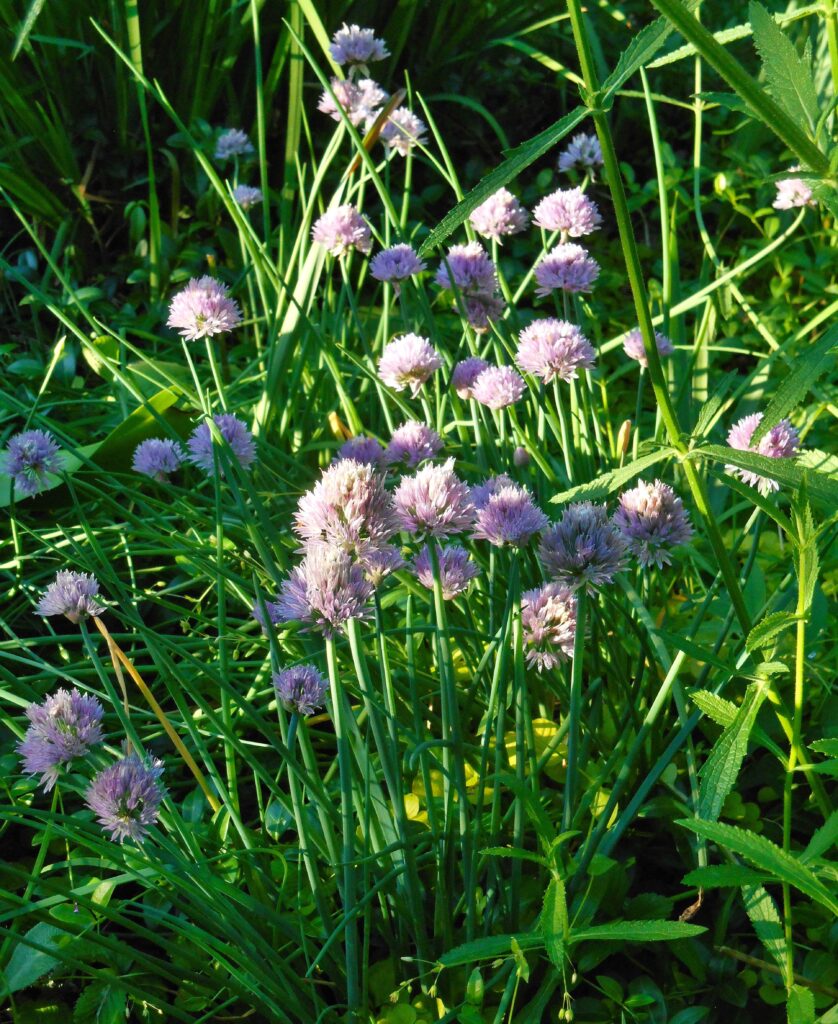
Enjoy eating the flowers and stems of chives, Allium schoenoprasum
Finding a Middle Way
For gardeners determined to have a garden and grow some of their own food, there is a middle way. If you have read the ingredients list on common deer repellents, you may notice that along with the more unsavory ingredients like rotten eggs and coyote urine, there are botanicals. There is a whole range of edible, even medicinal plants for us to grow that deer and rabbits not only won’t graze, but that contain fragrances which actively repel them.
Many of these plants are herbs and spices. Some we consider vegetables, like onions, garlic, and chilis. Most of these plants not only escape grazing, but they can also mask the fragrance of more desirable plants growing nearby, offering them some protection. Incorporate fragrant plants containing essential oils and other active ingredients in homemade repellents to spray on the foliage of tasty plants you want to protect.
Beautiful, Edible Deer Repellent?
Let’s examine a few of these desirable, edible garden plants that we can grow with confidence, knowing that deer and other grazing animals won’t eat them, and will most likely avoid them entirely.
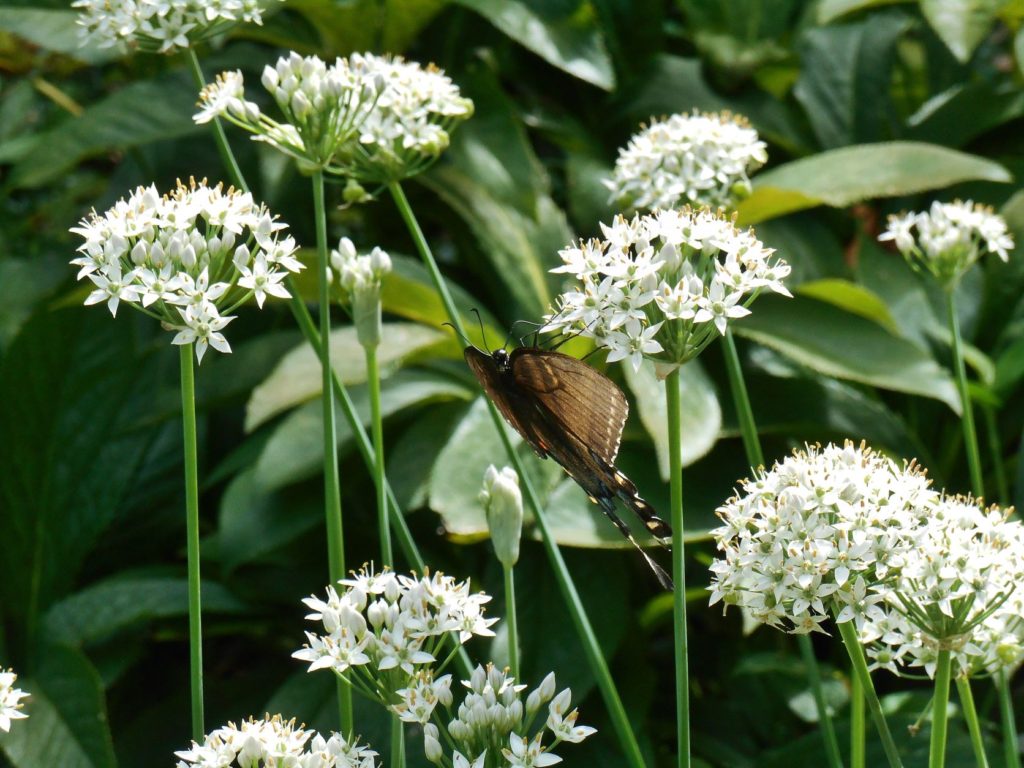
Culinary garlic chives, Allium tuberosum, attract butterflies and other pollinators. Enjoy eating both flowers and stems. Birds enjoy their seeds throughout the fall and early winter.
Alliums
Onions, garlic, garlic chives, chives, scallions, leeks, and shallots all belong to the Allium genus along with around 700 other species. Most grow in temperate areas of the Northern Hemisphere and are both hardy and drought tolerant. You may already have Allium canadense, or wild onions, growing in your lawn. While most species prefer full sun, a few species, like ramps or wild leeks, A. tricoccum, grow in the damp shade of mountain forests.
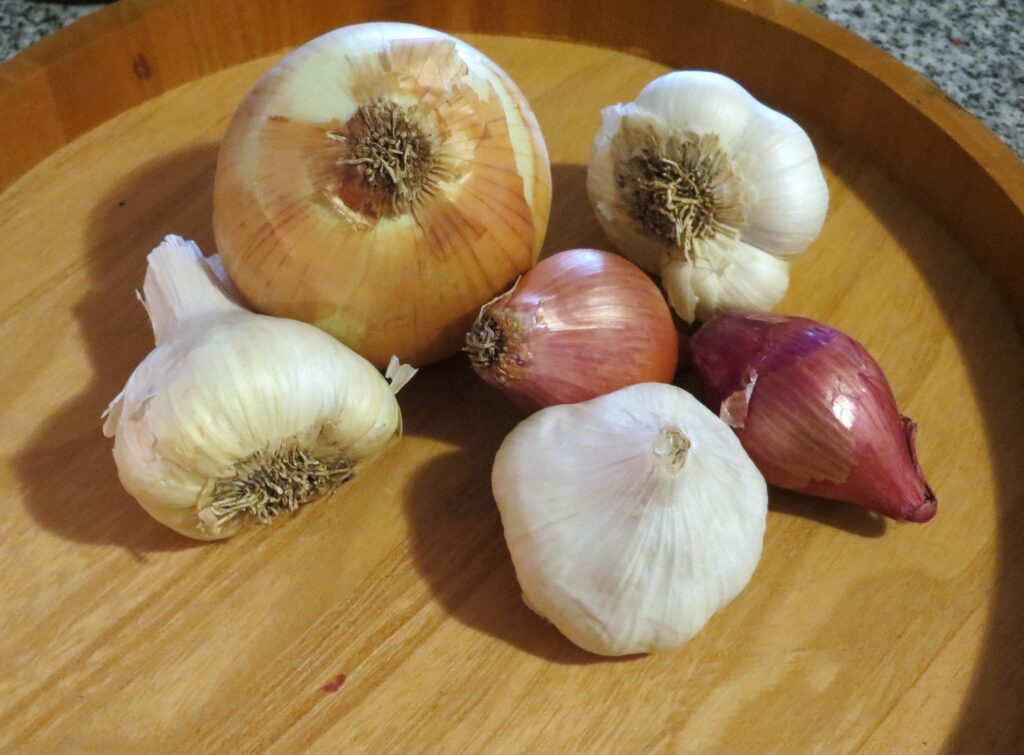
Garlic, onions, and shallots are edible bulbs belonging in the genus Allium. As with other types of bulbs, new plants can grow from the basal plate where the roots attach to the bulb. Slice off the bottom inch of an onion or shallot, then use the rest of the bulb normally. Place that bottom inch in a shallow bowl of water, roots down, and watch for new roots to grow. Change the water every two days to prevent bacterial growth in the water. Keep the rooting basal plate in a sunny spot, like a windowsill, as new shoots appear. You can either harvest the shoots as they grow for scallions, or grow them on into new onions. For onions, use a sharp knife to cut the basil plate into sections so that each section has both roots and shoots still attached to a piece of the basal plate. Plant each section into a container with potting soil and keep them in bright light. Transplant these new onion plants into the garden after the danger of frost has passed. It will take three to five months for a new onion bulb to grow.
Alliums, mostly edible, belong to the Aryllidaceae family of bulbs and have been under human cultivation for more than 5000 years. Garlic and onions were dietary staples in ancient Egypt and Sumeria. Onions and garlic are both highly nutritious, contain abundant antioxidants, and promote good health. Garlic is an antimicrobial, helping the body to resist a wide range of viruses and bacteria. It also lowers blood sugar and helps lower cholesterol and promotes heart health.
Alliums are all rather small plants, ranging from around 12” to perhaps 3’ tall. Long narrow leaves and a narrow stem arise from a bulb. Over time, clumps will form as unharvested bulbs divide. While most Alliums are hardy in our area, they aren’t evergreen. They will have limited use as a deterrent to grazers during the winter, but they may still slow down the voles a bit.
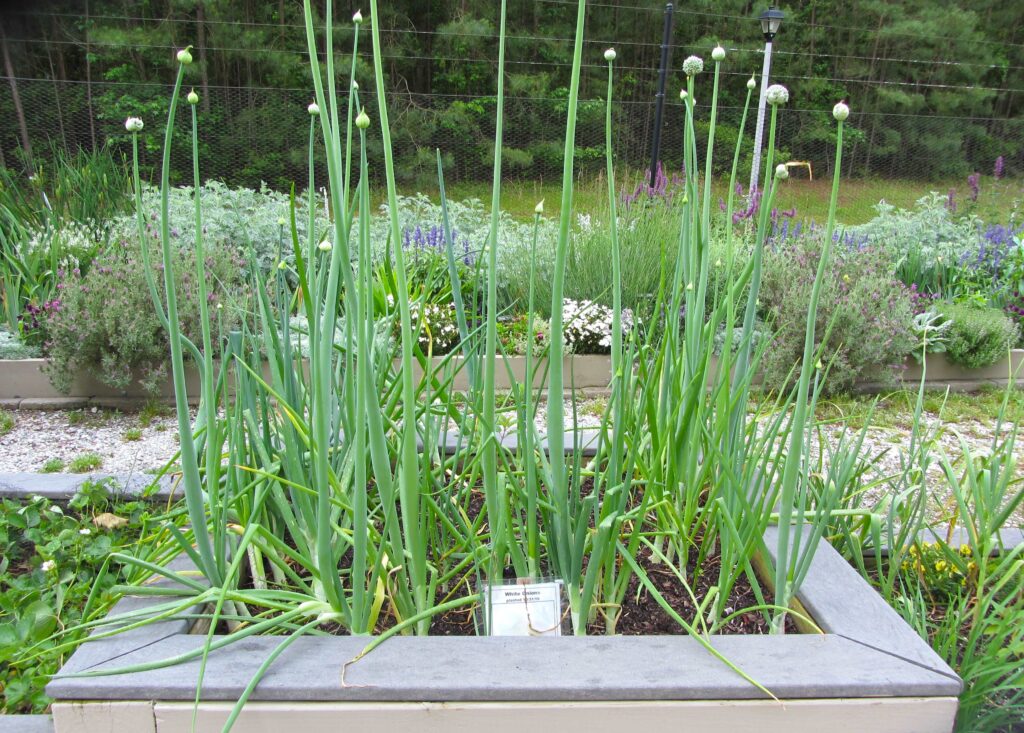
White onions prepare to bloom in a bed maintained by the ARC Therapeutic Gardening project at the Williamsburg Botanical Garden, May 2020.
Feeding Pollinators While Repelling Deer
All Alliums bloom with attractive flowers that attract pollinators. Some Alliums, like garlic and Egyptian or ‘walking’ onions, Allium x proliferum, form tiny bulbils at the top of their scape which can be planted for next year’s crop. Other Alliums, particularly garlic chives, produce abundant seeds and will quickly spread themselves around your garden.
Bulbs, stems, leaves, flowers, and sometimes seeds are edible in many species, but all have a strong flavor and deer repelling aroma produced by sulphides in the plant. You can plant onions, chives, garlic, leeks, and other Allium species around and between other garden plants, mixing them into other plantings to offer some protection by masking the fragrance of plants deer and rabbits may graze. One trick is to cut back the leaves by an inch or two every few weeks to make the plants’ fragrance even more pungent.
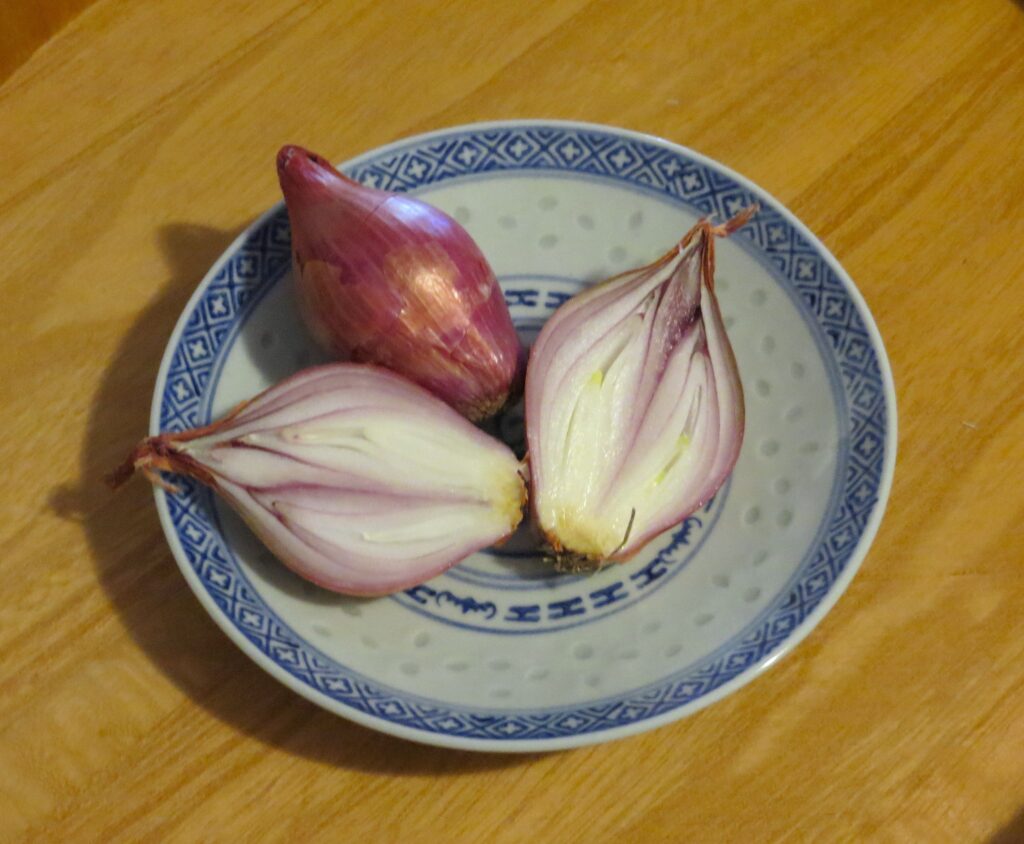
Shallots, Allium cepa, native to Asia, have a flavor similar to both onion and garlic. Also known as green onions, scallions, and spring onions, you can plant the bulb just as it comes from the grocery store. Either harvest the green tops as they grow as scallions, or allow the bulbs to grow through the spring and summer, harvesting the cluster of new bulbs once the plant begins to die back in early fall. New bulbs, known as offsets, will develop around the basal plate of the original bulb so that one bulb becomes a clump of new plants. Harvesting the leaves through the summer slows the process of new bulb production. Notice the individual ‘scales’ within the bulb. The beginnings of new leaves and stems are just waiting for the right conditions to grow.
Ornamental Alliums, A. cristophii, A. hollandicum, and A. karataviense, also offer protection to other plants. Their bulbs and stems may also be edible. Check the particular species you grow to make sure they are safe to eat if you plan to consume any part of them. An added advantage to planting Alliums in both ornamental and vegetable plantings is that the sulphides which give them their distinct fragrance and flavor prove unappealing to many animals besides deer, including snakes, rabbits, and squirrels.
Make a Home-brew Deer Repellent Spray
Crush most any Allium bulb and soak it in water for a day or two before straining out the solids. Garlic is particularly effective for using in spray animal repellants. Use one cup of water per clove of garlic. Add a few drops of dish detergent or olive oil, and additional essential oils such as clove or cinnamon oil, or powdered cayenne pepper as desired. Mix, strain out any solids, and then pour your homemade deer repellent into a spray bottle. Test your spray on just a leaf or two to make sure it doesn’t harm any plant you use it to protect. Wait a day before spraying the entire plant and surrounding soil.
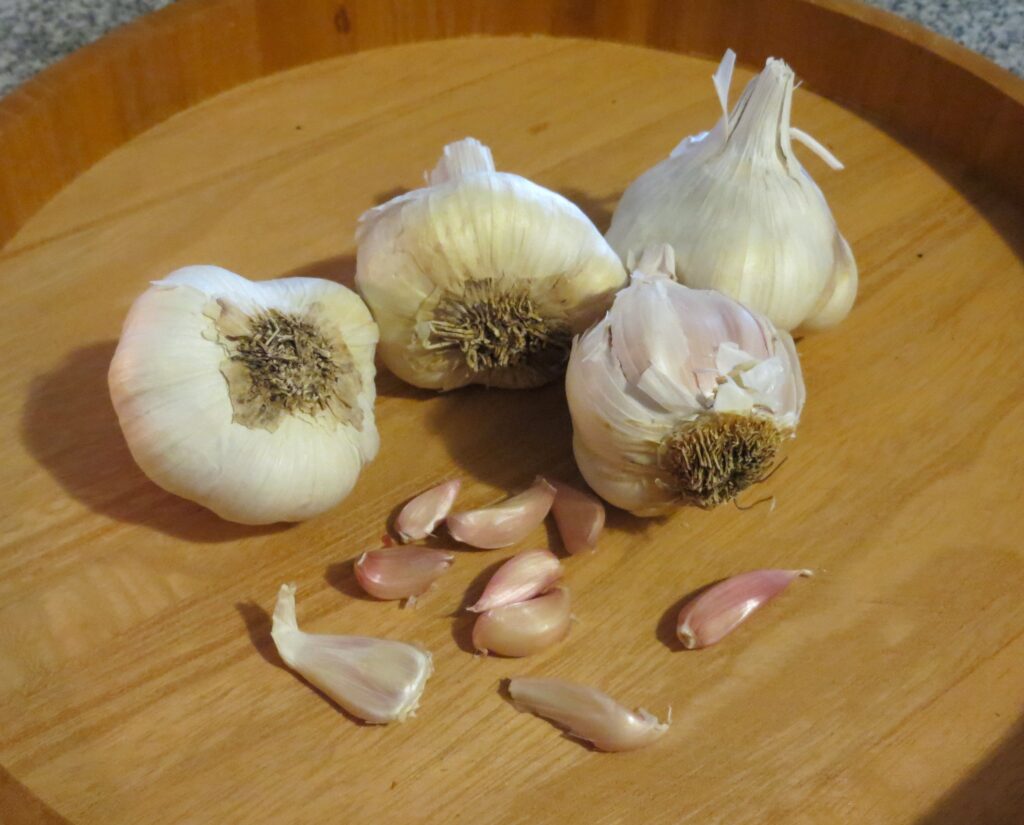
Each clove of garlic has a small bit of stem which will root. Plant small cloves in good potting soil in containers, or plant them directly outside where you want them to grow in the spring. Even the tiny cloves will eventually grow into a new bulb.
There are many ways to introduce Alliums to your garden. Order seeds, onion sets, garlic cloves, or seedling plants, or purchase these locally. Alternatively, it is easy to plant garlic cloves purchased at the grocery store. Small (raw) ‘cocktail’ onions, shallots, and even scallions with their roots still intact sold at the grocery store can be planted instead of eaten.
Plant most Alliums in full to part sun, in well-drained rich loam. Good drainage is important for Alliums, so avoid heavy clay and poorly drained areas of your yard. If you don’t have an area that already drains well then consider building a raised bed for your Alliums or grow them in containers.
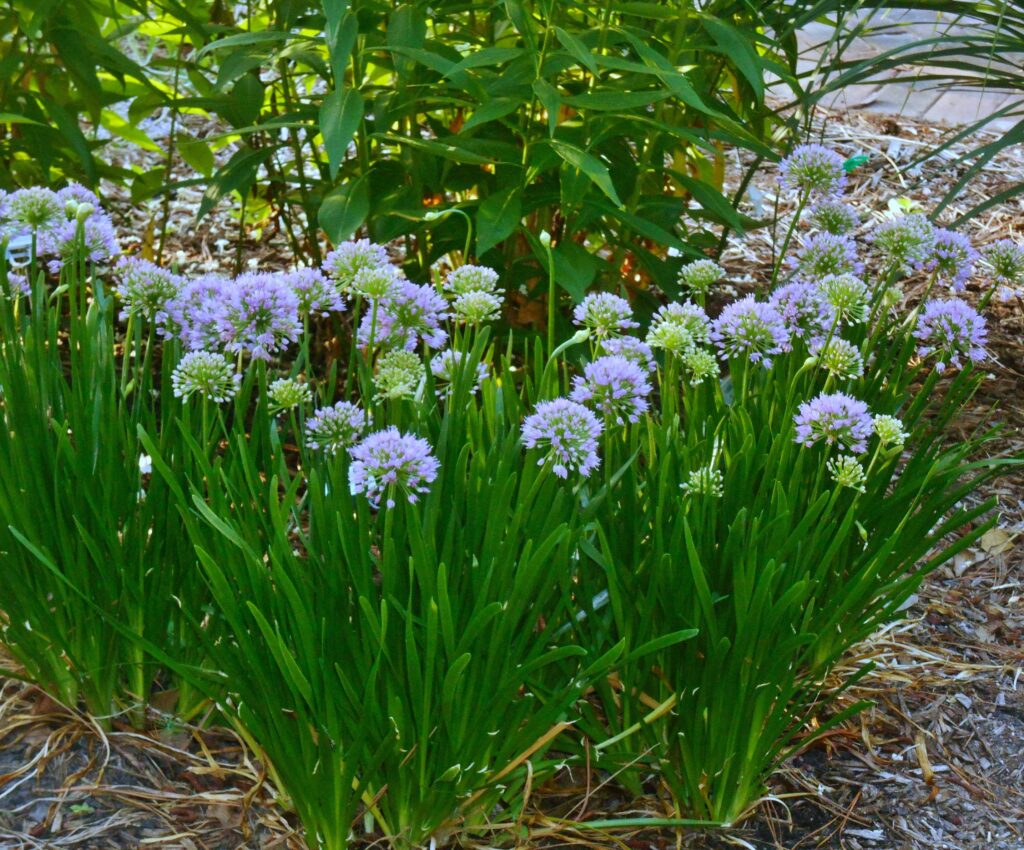
Ornamental Alliums support pollinators over a long season. Grow in full to part sun in soil enriched with compost. The Williamsburg Botanical Garden 2021.
Enrich the soil with compost at planting time. Space plants 2”- 5” apart depending on the mature size of the bulb. If planting onions or garlic for a harvest, you might add additional fertilizer that contains sulfur, but always do a soil test first to learn which amendments your soil needs to grow onions well, and how much to use. The tiny cloves in a head of garlic that seem too small to peel to use in cooking may still be planted out to protect and shield other plantings. While garlic is usually planted in late summer or fall, it can be planted through the winter into early spring. Plant ornamental Alliums and culinary onions in fall or spring. Small pots of chives should be planted out in spring or early summer.
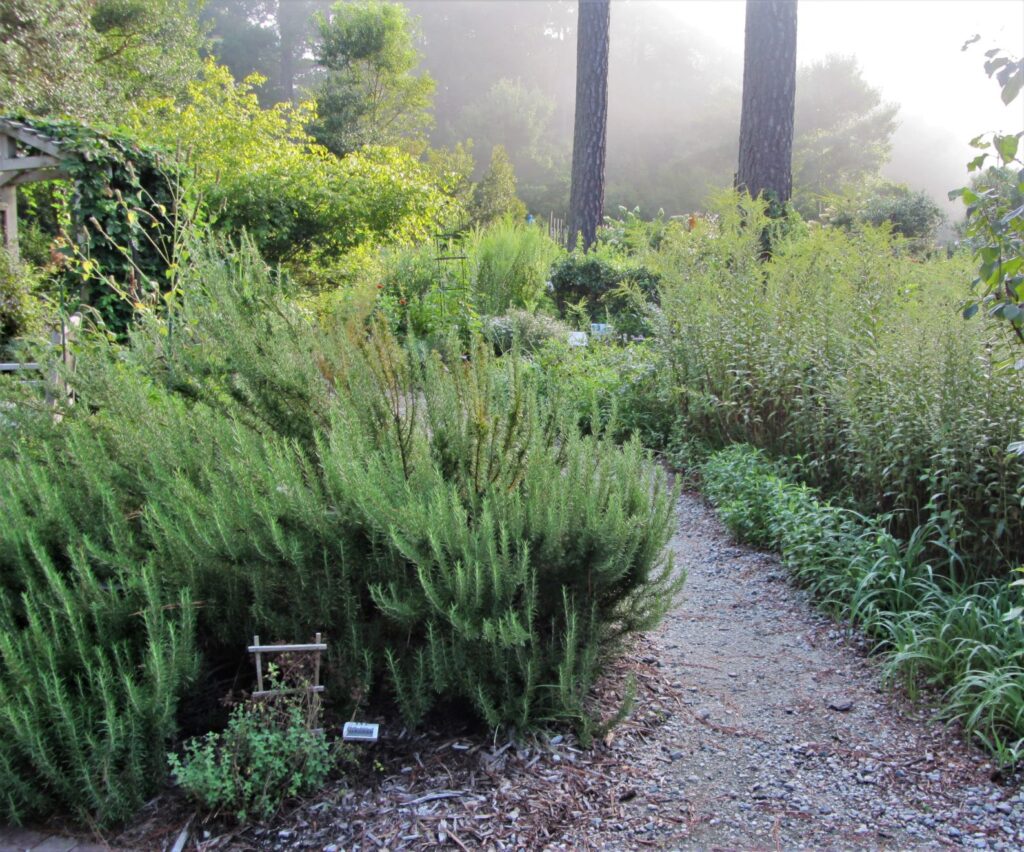
Rosemary grows in the herb garden at the Williamsburg Botanical Garden. Planting fragrant herbs like rosemary and lavender near the entrances to paths and walkways can discourage deer.
Herbs
The essential oils that give herbs their pungent fragrance and flavors repel deer, rabbits, and a variety of other animals. These plants very rarely show any damage from grazing. Use them to both shield other plants in the garden and to brew spray on repellents. Whether you purchase essential oils of rosemary, mint, thyme, sage, oregano, cloves, cinnamon, or lavender to add to your repellent sprays, or whether you steep cuttings of your own home-grown herbs in boiling water to use as the base for a repellent, these plants prove very effective at hiding the fragrance of garden plants that deer and rabbits will graze. Mints, rosemary, and lavender are considered the most effective herbal fragrances for repelling animals.
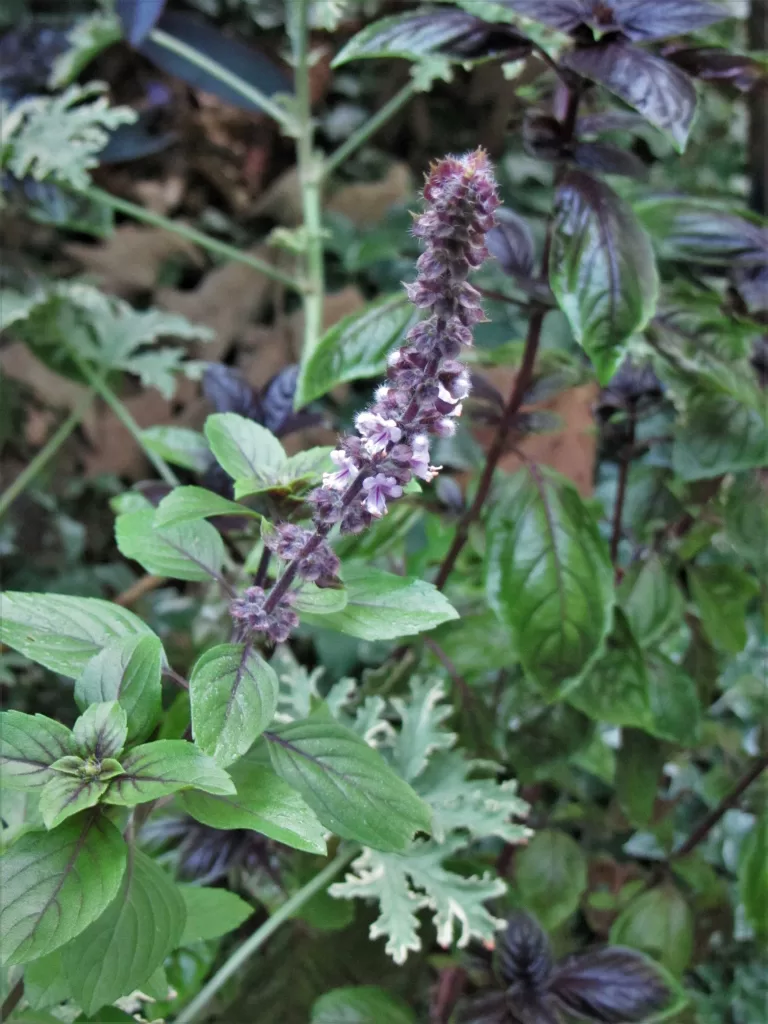
Basil, Ocimum basilicum, and other mint-family flowers attract insect pollinators and hummingbirds while repelling deer. Most members of the mint family are also delicious.
Evergreen Herbs Provide Year Round Protection
Evergreen Mediterranean herbs like rosemary, thyme, lavender and sage may be harvested for the kitchen year-round, and also offer some protection for other garden plants year-round. Mints and Salvias are especially beloved by pollinators. Ornamental Salvias and mints, like cat mint, will also escape browsing, as will tender and annual herbs like basil, chamomile, and cilantro. Most herbs are very pretty and can be planted among vegetables and ornamental flowering plants to mask the scent of these plants that deer want to graze.
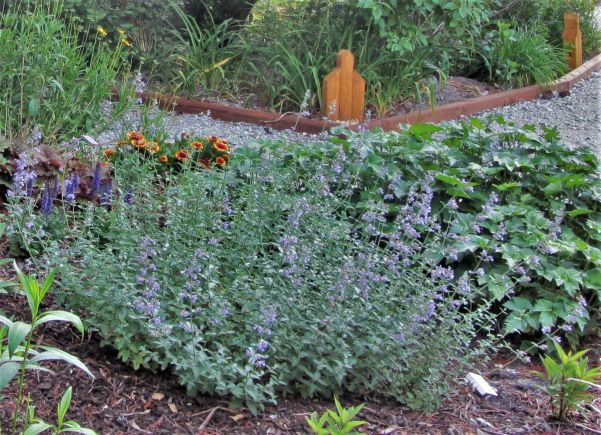
Calamint grows at the Williamsburg Botanical Garden in May of 2021. Nepeta normally isn’t considered an edible herb, but it still has many uses.
Use fragrant herbs around the perimeter of your garden, along paths, at entrance ways, and as borders around planting beds. Place them where their fragrance will discourage deer from exploring your garden any further.
Herbs Are Easy to Grow
Most herbs prefer full sun and fertile, well-drained soil. They adapt well to growing in both containers and raised beds where drainage is an issue. Herbs generally need little or no fertilizer to grow well and develop stronger fragrance growing in bright sun without fertilizer. Find small pots of herbs in most well stocked grocery stores year-round. Herb plants appear at garden centers and wherever vegetable plants are sold each spring. Most herbs root easily in water and are very quick to grow from cuttings.
Keep in mind that most members of the mint family spread rapidly on underground rhizomes and should be grown in containers if you don’t want them to wander freely around your garden beds, lawn, and anywhere else they can sink a root.
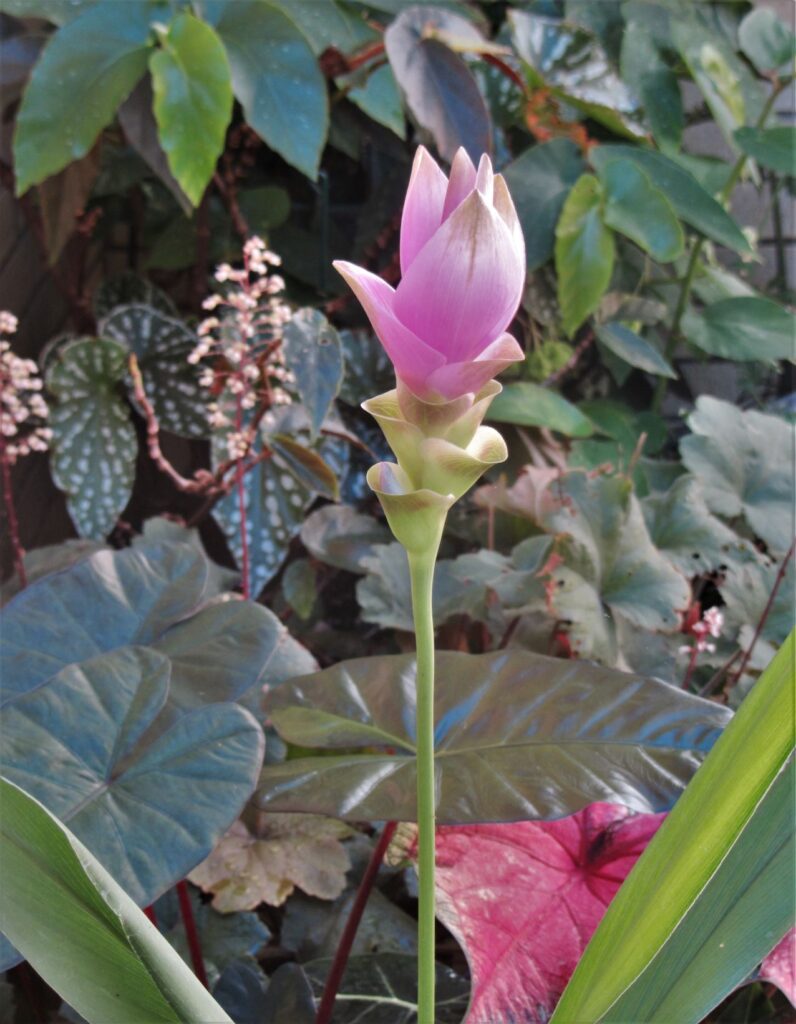
Turmeric blooms in late summer on attractive plants. Plants are easy to start from rhizomes purchased at the grocery store. Harvest turmeric rhizomes for use cooking.
Ginger and Turmeric
True ginger, Zingiber officinale, native to tropical Asia, is one of the oldest known spices, along with green cardamom, Elettaria cardamomum and black cardamon, Amomum subulatum. Both belong to the Zingiberaceae or ginger family. The ginger family includes about 50 species of flowering plants that grow from aromatic, creeping rhizomes. Many of these plants are edible and medicinal. Several types of ginger, turmeric, and cardamom all belong to the ginger family. Ornamental gingers, Hedychium spp., belong to this same family and are also ignored by deer.
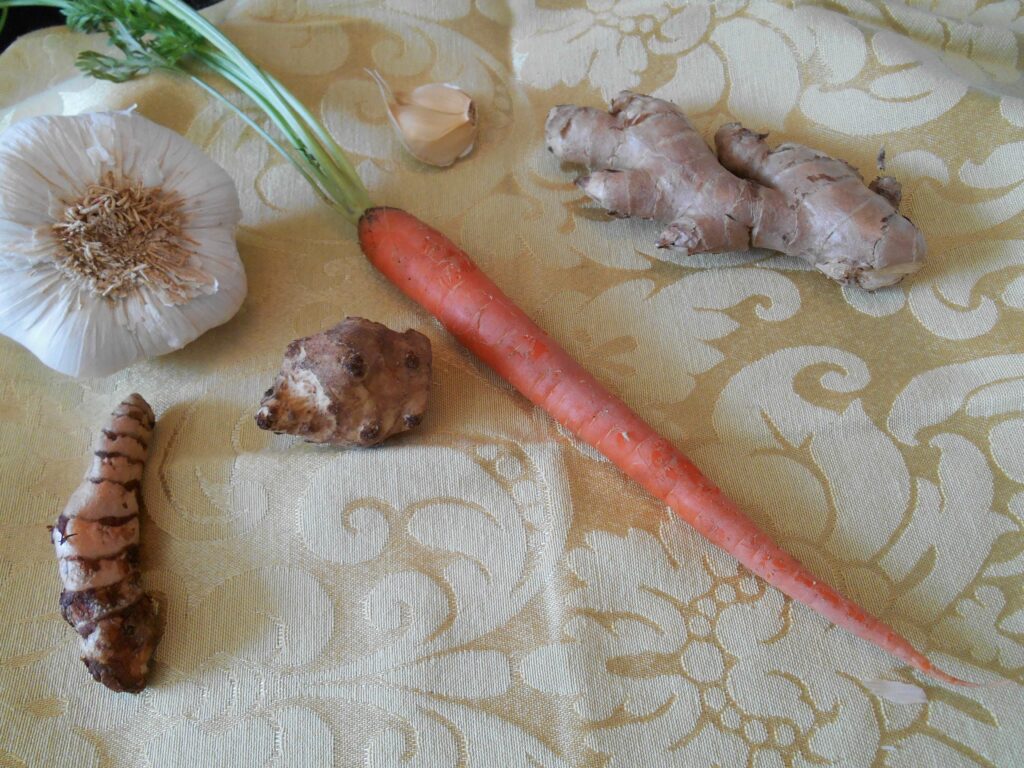
(From Left, clockwise) Turmeric, garlic, carrot, ginger, and Jerusalem artichoke. Buy these plants at your local grocery store and plant them in your garden. Deer will eat carrot plants and Jerusalem artichoke plants unless they are well protected.
Grow Your Own Plants From the Market’s Produce Section
Ginger and turmeric, both pungent rhizomes that are easy to find in the produce section of most grocery stores, can grow into attractive plants. Deer won’t bother them. Plant pieces of fresh ginger, Zingiber officinale, or turmeric, Curcuma longa, about an inch deep in good potting soil. If you cut up your piece of ginger or turmeric into smaller pieces, allow the cut surfaces to air dry for a day or two before planting them. Make sure that each piece you plant has one or more buds or points of growth.
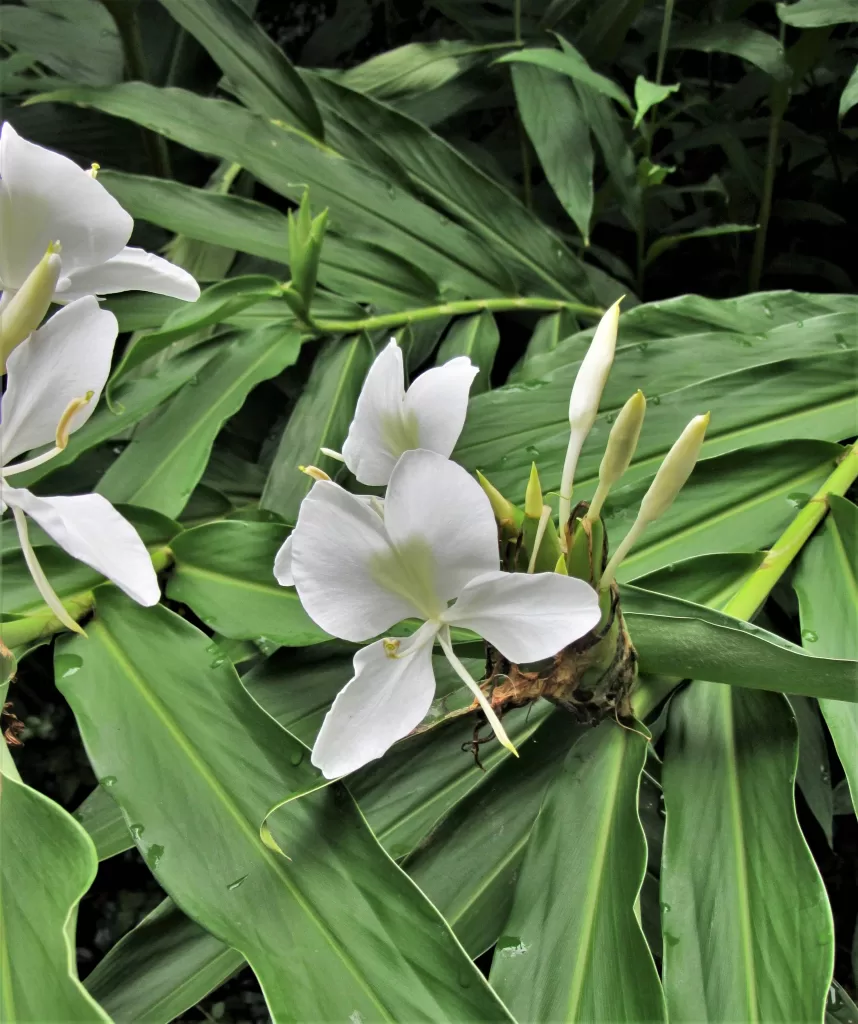
Butterfly Gingerlily, Hedychium coronarium, is an intensely fragrant ornamental ginger beloved by pollinators. Deer never nibble on its leaves or approach this deciduous perennial plant, which blooms in late summer.
Start these plants indoors in late winter or early spring and move them outside to a partially sunny spot once danger of frost has passed. Wait until the soil has warmed to around 60F before planting them into a garden bed in prepared loam. Ginger requires excellent drainage to prevent root rot, but turmeric thrives in moist to wet soil.
Culinary ginger, an Asian herb hardy in Zones 9-12, can grow into a 4’ tall by 3’ wide plant in part sun or part shade by autumn. Dig the plant to harvest its rhizomes. Deer and rabbits won’t eat this plant’s flowers or foliage. Plants grown in a container will overwinter indoors.
Turmeric, native to India and hardy in Zones 8-11, can grow to 4’ tall by 4’ wide by autumn. It enjoys hot, humid summer weather and full sun. This attractive plant has beautiful flowers by late summer. If grown in a container, re-pot as the rhizomes grow larger because they can eventually crack the pot. Bring the plant indoors in late autumn to hold it over for the following year. Harvest the edible rhizomes by digging up the plant, removing some rhizomes, and then replanting the rest.
Ginger and turmeric rhizomes can be used in a variety of ways, both fresh and dried. They are essential flavorings in many Asian cuisines. Both have medicinal uses in addition to flavoring foods. Turmeric, essential to curry powder, is also used to color foods yellow and as a fabric dye.
Fennel
Fennel may be considered a vegetable, a spice, or an herb. It really depends on which part of the plant you use and how you use it. Fennel, bronze fennel, Florence fennel, and sweet fennel are names for varieties of Foeniculum vulgare. Fennel is a member of the Apiaceae or Umbelliferae family, which includes carrots, parsley, anise, cilantro/coriander, and celery. Most all parts of the fennel plant are edible from its delicate, ferny leaves to its bulbous base. The only part of this fragrant, delicious plant not commonly consumed are its roots.
Chop the leaves for use fresh on salads, deviled eggs, in omelettes, and as a garnish. Brew them fresh with a few fennel seeds for a delicious beverage. Fennel stems and flowers may be used as a garnish and in salads. The base may be sliced thinly and used raw in salad or sauteed, braised, or roasted in a variety of dishes. Fennel seeds are a frequent ingredient in baked goods and stir fries. This plant has a delicious, anise or licorice- like flavor and aroma which is utterly repulsive to deer.
Grow this short lived perennial as an annual, harvesting the base in late summer, or as a perennial in Zones 4-9. If the base is cut at ground level with the roots left undisturbed, it may re-grow from its roots. Fennel will grow on a wide range of soil types in full to part sun with average moisture. This drought tolerant vegetable will also grow on clay if it has good drainage, or plant it in a large container with flowers, herbs, or other vegetables.
While deer and rabbits won’t bother fennel, swallowtail butterflies use it as a host plant. The caterpillars will strip some leaves but won’t kill the plant. Fennel attracts a variety of pollinators to the garden, requires minimum care, and will reseed. Buy plants locally in the spring or start fennel from seed. Expect fennel to grow to 4′-6′ tall depending on available light and moisture. It is a very tough, versatile vegetable that can be harvested again and again.
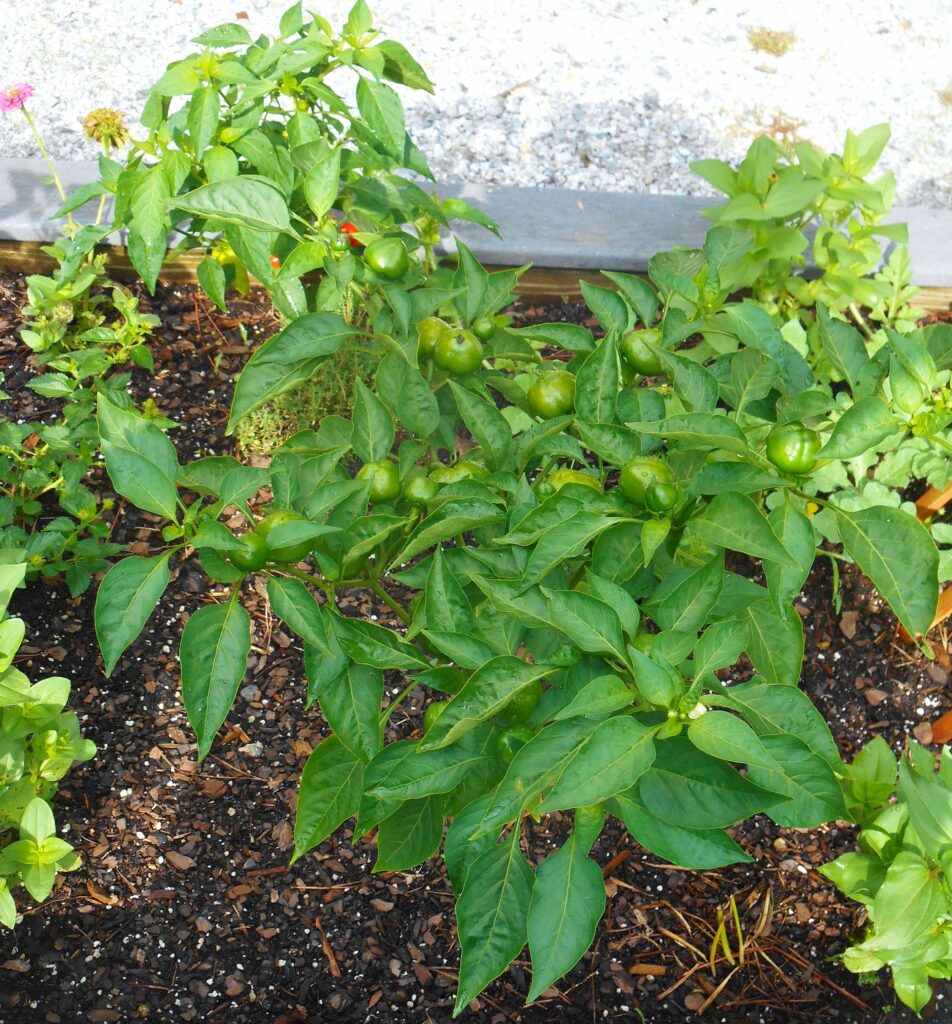
Both hot and sweet pepper plants have a similar appearance and grow best in full sun. They are heavy feeders and need both rich soil and consistent moisture for best production. Pick peppers as they ripen to encourage new flowers to bloom. These sweet peppers grew in the Therapeutic Gardening beds at the Williamsburg Botanical Garden in 2020.
Hot peppers
Deer will eat pepper plants, but we can still grow hot pepper varieties to use their dried flesh in repellent sprays. The white membranes which hold the seeds contain the highest concentration of those volatile oils which repel animals. We might expect hot peppers to be safe from browsing, but deer will still sometimes eat the leaves and stems of these plants, which aren’t hot. If you grow hot peppers, protect them from browsing, especially before their peppers develop, as you would protect other vegetables and ornamental plants.
Choose hot and spicy varieties like cayenne, Capsicum annuum, or tabasco pepper, Capsicum frutescens. There is a wide variety of peppers native to many parts of the world, and they have been under cultivation for centuries. Peppers are used to season foods but can also be used medicinally. Hot peppers are crucial to many ethnic cuisines. Their degree of hotness is measured in Scoville units on a scale from zero to over a million.
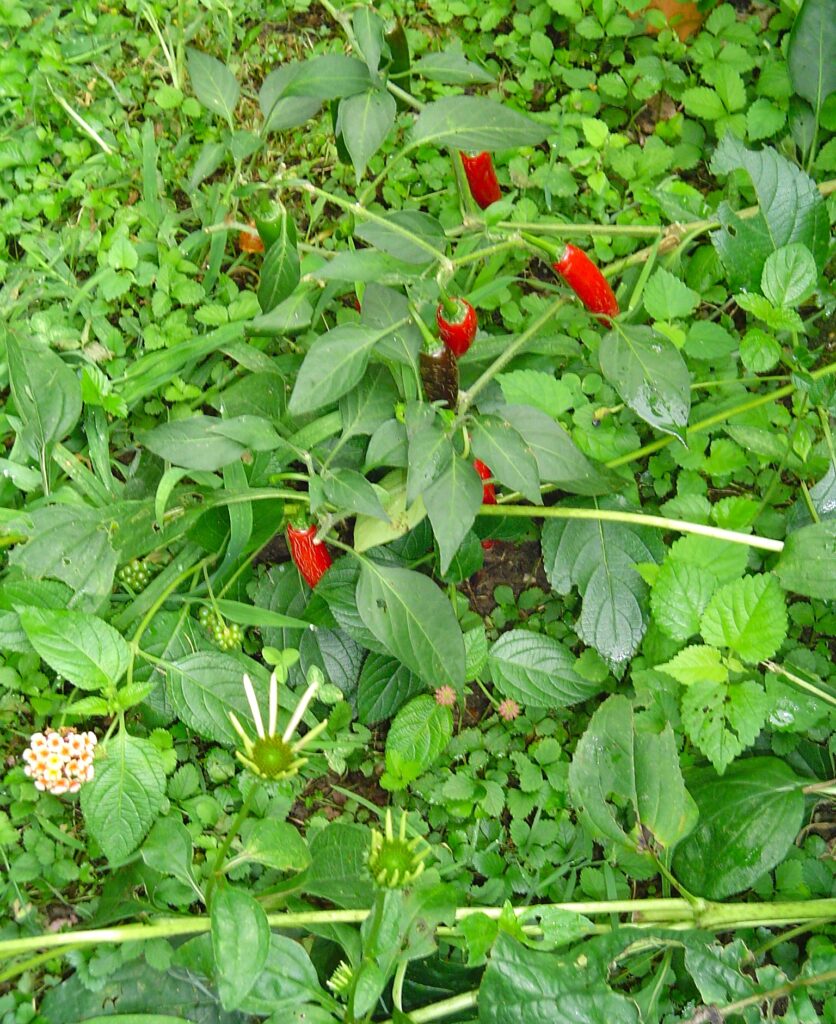
Hot chili peppers usually ripen to shades of orange, scarlet, and yellow. Grow hot peppers among flowers and herbs to provide more protection from animals that might graze the plant.
Capsaicin is the chemical compound in peppers which makes them hot. It can be applied topically to relieve pain. It is an irritant which can cause burning and swelling in the eyes, mouth, and nose, and burning on the skin. Capsaicin can be used as a pesticide and is even used to make personal defense ‘pepper’ sprays to ward off attackers. Add hot pepper to homemade deer repellents to protect other plants. Peppers are high in vitamins, antioxidants, and other healthy compounds. Researchers use them to treat a wide range of health conditions.
Start peppers from seeds in early spring or buy plants in mid-spring. Plant pepper plants in well-drained loam soil in full sun. These are attractive plants and may be grown along with flowers and herbs in ornamental container plantings. Peppers are heavy feeders and respond well to both compost and fertilizer. Wait until the weather is settled and warming up before planting peppers outdoors. Harvest the last fruits before the first frost of the season. Peppers are grown as annuals in our climate.
While many plants avoided by deer, like daffodils, are highly poisonous, there are a few edible, non-poisonous plants we can grow with confidence. Strong fragrances, essential oils, and sulphides offer natural protection for these special plants. The very substances which make them unappealing to deer often bestow them with healthy properties that make them especially valuable additions to our gardens.
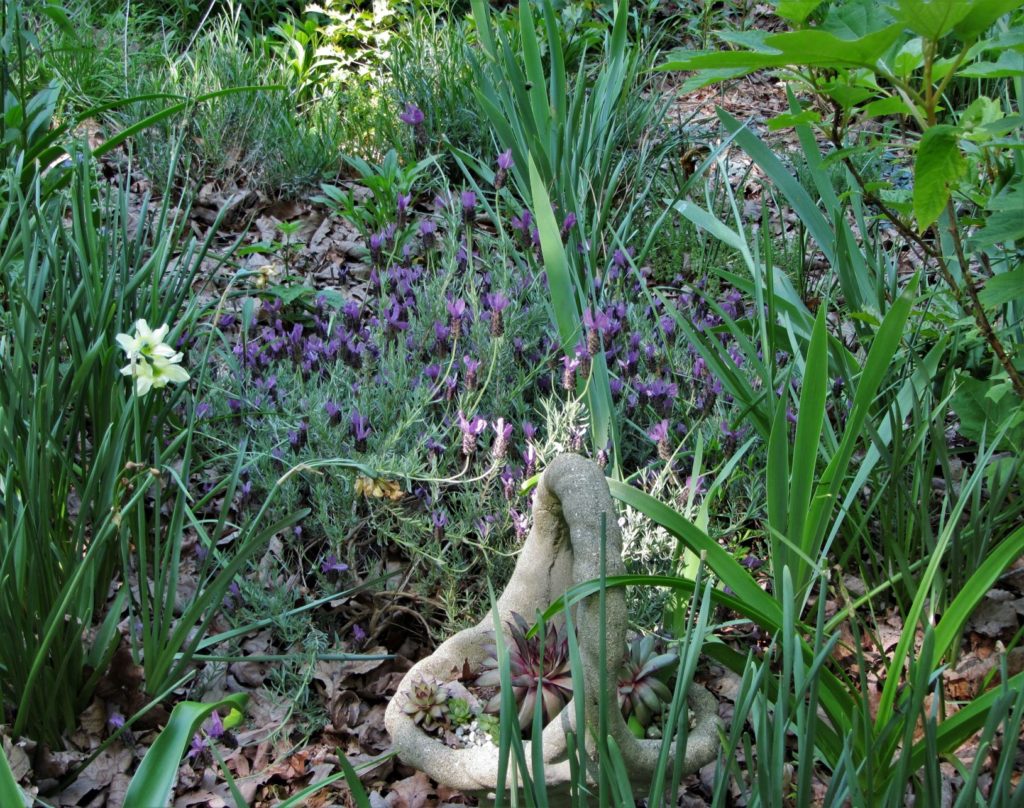
Every part of a Narcissus is highly poisonous, so they will never be eaten by deer. Herbs, like this Spanish lavender, have an unappealing fragrance and texture that the deer avoid.
Learn More About Gardening Around Deer
All photos by E. L. McCoy



